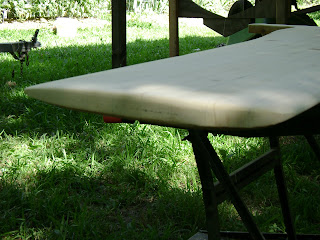On of the places I'm deviating from the plans is on the access to the side seats compartments. Most builders use top-access seat hatches which require additional framing and leave a seam right in the middle of the most used sitting space. Like this:
 Rough opening for seat hatch.
Rough opening for seat hatch.
 Framing and gutters to drain water into cockpit.
Framing and gutters to drain water into cockpit.
 Seat with gutter molded around framing.
Seat with gutter molded around framing. From a storage standpoind, they are nice because they give quick access to the large side tanks that make an ideal storage place for fenders, PFDs, and long items like fishing rods or umbrellas. So there's a trade-off in not going with these hatches. Instead, I'm using eight inch quarter-turn inspection ports located on the seat sides.
 Cutting the openings.
Cutting the openings. Fine-tuning with a Dremel.
Fine-tuning with a Dremel.
 They fit!
They fit!These ports will be much more watertight in a knock down. Plus the size of the opening still fits medium-sized objects like fenders. PFDs will not fit, but the front and rear compartments have plenty of room for that kind of stuff. By placing the openings about three feet from the side bulkhead, I can reach almost all of the compartment with an extended arm.


It may turn out that items roll to the ends of the compartments out of reach. If so, I may have to add additional port at the other ends. But for now I'm going with four ports, one for each side tank.
The quarter-turn hatches are from Duckworks. I've heard that they tend to be a bit more reliable (leak-proof) that the screw-in models. Once they are fully tightened you can feel them click. At this point they are pretty well sealed. However, they are also a bit difficult to re-open. They may loosen up over time, but for now it seems like a good idea to have a tool to help lever them open when needed. This hatch wrench is made of a few plywood scraps and a sturdy piece of pine for a handle.


Once I cut the opening for the hatches, I decided to bulk up the frame of the opening a bit with some 3/8" plywood backers. This will stiffen the area substantially and give the screws for the hatch frames more material to bite into.


Since I'm not using the seat-top hatches I added a few extra pieces of framing for the seat tops to rest on. This might be unnecessary, but the added weight is small and it is going right to the place where people are most likely to be sitting as well as stepping on and off the boat.
Once the hatch openings were cut it was time for a nap.

I'm stretched out on the cockpit floor behind where the thwart will be located. There is easily enough room to sleep between the seats. My plan is to have floor boards that can be raised to the same height as the seat tops, making a single platform of the rear half of the cockpit. With these in place, the beam of the boat is enough for someone my height to lay sideways. Two people sleeping on the boat should not be a problem at all.
This is the backer block for the bow eye. It's made from a solid chunk of cedar which is light, rot resistant and has a high compression strength. It will be epoxied and glassed in place soon.


Pretty soon I will be ready to put the seat tops on. But first the side compartments must by sanded smooth and epoxy coated to keep moisture out. The first couple times I tried to coat vertical areas I always had problems with drips. This was true no matter how thinly I tried to apply the epoxy. So now I have a different approach. I mix the epoxy wit just enough silica thickener to create a mixture that will resist running. It doesn't have to be as thich a a fillet mixture because it will be going on in such a thin layer. I go with a mixture about the thickness of Ranch dressing. Instead of applying it with a brush, I use a squeegee. It goes on in a thin and consistent layer that does not run and requires very little if any sanding once it has cured. I can't be sure, but I think it actually spreads a bit further then an un-thickened batch of the same volume.

Centerboard trunk is going in today. Will post more soon.






























